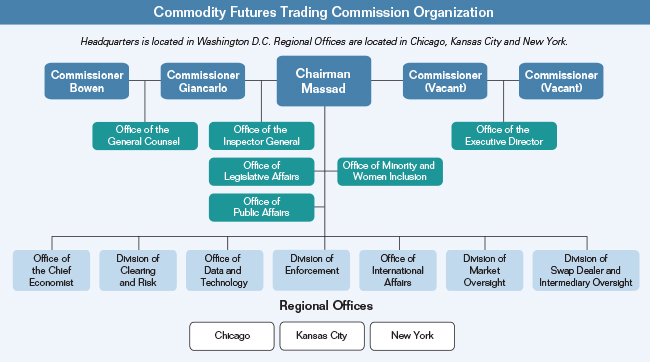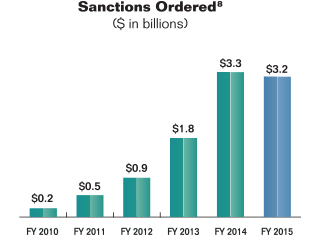
CFTC Mission
To foster open, transparent, competitive, and financially sound markets to avoid systemic risk; and to protect market users and their funds, consumers, and the public from fraud, manipulation, abusive practices related to derivatives and other products that are subject to the Commodity Exchange Act.
A Message from
the Chairman
I am pleased to present the Agency Financial Report for Fiscal Year (FY) 2015, which details our performance accomplishments and audited financial statements for this period. Over the past year, the U.S. Commodity Futures Trading Commission (CFTC or Commission) continued to make progress on behalf of the American people. We have brought increased transparency and sensible oversight to the derivatives markets, so they continue to operate with integrity and stability.
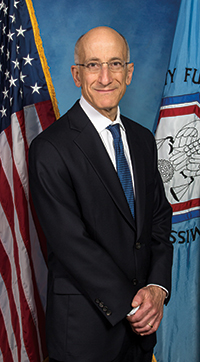
The CFTC oversees the U.S. derivatives markets, which include commodity futures, options, and swaps. Although most Americans do not participate in these markets directly, they are vital to our economy, affecting the prices we pay for food, energy and other goods and services. They are critical to the economic success of many businesses, farmers and ranchers in the United States, who use them for price discovery and to manage routine commercial risk.
The Commission’s key focus remains to foster transparent, open, competitive and financially sound markets. Our mission is to protect market participants from fraud, manipulation and abusive practices, while safeguarding customer funds. And we seek to protect the public from the buildup of excessive risk, the very type that contributed to making the 2008 financial crisis the worst since the Great Depression.
The derivatives markets are continuously evolving, driven by new technologies, innovation, competition and a global marketplace. As a result, the Commission’s work is constantly changing, increasingly complex and focused on the challenges that lie ahead.
This past year marked significant continued progress implementing the Dodd-Frank Wall Street Reform and Consumer Protection Act of 2010 (Dodd-Frank Act) and bringing transparency to the over-the-counter swaps market. Clearing is now mandated for most interest rate and credit default swaps. Today, approximately 75 percent of swap transactions are being cleared, as compared to about 16 percent in 2007. We now require registration and regulation of swap dealers. More than 100 are now registered and required to comply with strong risk management practices.
There are now more than 23 swap execution facilities (SEFs). The volume of trading taking place on SEFs is growing. We have four swap data repositories (SDRs) that are collecting market data and making it available publically. As a result, market participants, the public, and we as regulators have much more information regarding the swaps marketplace.
The CFTC also continues to fulfill its traditional duties in overseeing the futures and options markets. We are working tirelessly to help these markets operate safely and with integrity.
Over the past year, the Commission continued to focus on an aggressive enforcement program that protects customers and prevents fraud and manipulation. The Commission filed 69 new enforcement actions in FY 2015 and imposed a record $3.1 billion in civil monetary penalties against wrongdoers. This included an $800 million sanction, the largest in Commission history. In addition to these sums, the CFTC was also awarded $59 million in restitution and disgorgement orders, bringing its total monetary sanctions to over $3.2 billion for the year. Robust enforcement is vital to maintaining the integrity of our markets, and will remain a priority going forward.
Over the past year, the Commission has placed a particular emphasis on making sure that, amidst various regulatory changes, commercial end-users can continue to use the derivatives markets efficiently and effectively. Many companies rely on these markets to hedge price, production and other types of risk. For example, we exempted commercial end-users from our proposed rule on margin for uncleared swaps. We amended our rules so that publicly-owned utility companies can continue to effectively hedge their risks in the energy swaps market, which helps them provide reliable, cost-effective service to their customers. We approved a modification to the “residual interest” rule, which can affect when customers must post collateral with clearing members. We exempted end-users from certain recordkeeping requirements to avoid undue burdens. And we have made some important rule adjustments and clarifications addressing contracts with embedded volumetric optionality.
Over the past year, the Commission also has been very focused on the resiliency of clearinghouses. With the increased significance they have taken on in the financial system, it is important we make sure they are strong and stable. In addition to our domestic efforts on this issue, we are leading substantial work that is taking place internationally—working with foreign regulators and other U.S. agencies. We are also working to strengthen the security of our financial markets against cyber-attacks and technological failures.
Commission staff has also taken a number of actions to fine-tune our rules to improve SEF trading. However, SEF trading is still new, and we still have significant work ahead of us. Our objectives go beyond improving and further encouraging the open, transparent and competitive trading of swaps on SEFs. It’s also about making SEF trading attractive, to build participation and create a strong foundation upon which it can thrive.
The Commission has also made a number of technological improvements this past year. Among many other efforts, the CFTC opened its “OPERA” (Organizations, Products, Events, Rules and Actions) portal, which allows submissions to be electronically filed with the Commission. Over the course of the year, nearly 96 percent of the product and rule amendment filings made by designated contract markets, SEFs, and SDRs were filed through OPERA, making data entry, filings and review more efficient.
How far we have come is a credit to the hardworking and dedicated efforts of the professional staff of the CFTC. Their significant contributions are highlighted in the pages that follow.
Although much progress has been made, there is much more we need to accomplish. The Dodd-Frank Act greatly expanded the CFTC’s responsibilities. The $270 trillion swaps market we are now tasked with overseeing is vast, global in nature and dramatically larger than the futures and options markets we also must oversee. But simply put, our budget has not kept pace with this expansion. As a result, our markets cannot be as well-supervised, participants cannot be as well-protected, and market transparency and efficiency cannot be as fully achieved as we believe the American people deserve.
The CFTC places a strong emphasis on being an effective steward of its operating funds. The Chief Financial Officer’s (CFO) message includes the results of the independent audit of our FY 2015 Financial Statements. The auditors have identified a material weakness in financial reporting related to the Commission’s historic practice with respect to the recording of lease obligations. When the Commission entered into multiple year leases, such as in 1994 for its Washington office, it recorded only the annual lease payments each year, rather than the full multi-year obligation in the year the lease was initiated. The Commission is awaiting a U.S. Government Accountability Office (GAO) opinion on this matter, and it is reasonably possible that the CFTC will need to recognize the unfunded obligations covering all future payments. We believe that this is an isolated issue which does not impact our overall internal controls. The Commission remains committed to high standards of financial operations, reporting, and accountability, and to the continued improvement of our financial management and internal controls.
The CFTC and its talented staff worked diligently during fiscal year 2015, and accomplished a great deal on behalf of the American public. As a result, the markets we oversee are stronger, more transparent, and more competitive.
![]()
Timothy G. Massad
Chairman
January 15, 2016
The Commission in Brief
The Commission in Brief presents a high-level summary of CFTC. See below for an overview of CFTC and its staff, and the CFTC regulatory landscape during FY 2015.
-
Organization and Location
The Commission consists of five Commissioners, with two positions currently vacant. The President appoints and the Senate confirms the CFTC Commissioners to serve staggered five-year terms. No more than three sitting Commissioners may be from the same political party. With the advice and consent of the Senate, the President designates one of the Commissioners to serve as Chairman.
The Office of the Chairman oversees the Commission’s principal divisions and offices that administer and enforce the CEA and the regulations, policies, and guidance thereunder.
The Commission is organized largely along programmatic and functional lines. The four programmatic divisions—the Division of Clearing and Risk, Division of Enforcement, Division of Market Oversight, and the Division of Swap Dealer and Intermediary Oversight—are partnered with, and supported by, a number of offices, including the Office of the Chief Economist, Office of Data and Technology, Office of the Executive Director, Office of the General Counsel, and the Office of International Affairs. The Office of the Inspector General is an independent office of the Commission.
The Dodd-Frank Act established the CFTC Customer Protection Fund for the payment of awards to whistleblowers, through the whistleblower program, and the funding of customer education initiatives designed to help customers protect themselves against fraud or other violations of the CEA or the rules or regulations thereunder.
The Commission is headquartered in Washington D.C. Regional offices are located in Chicago, Kansas City and New York. The CFTC organization chart is also located on the Commission’s website at http://www.cftc.gov/About/CFTCOrganization/index.htm.
-
Our People
Collectively, the Commission employs 731 full-time permanent employees that compute to 690 full-time equivalents (FTE)1 in FY 2015. CFTC staff are comprised of 75 percent direct mission staff (attorneys, economists, auditors, risk and trade analysts, and other financial specialists) and 25 percent management and support staff to accomplish four strategic goals and one management objective in the regulation of commodity futures, options, and swaps.
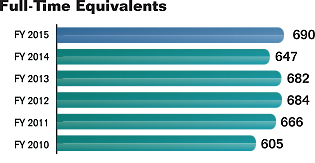
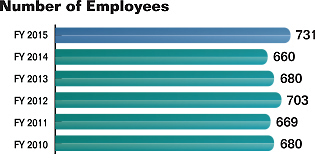
Attorneys across the CFTC’s divisions and offices represent the Commission in administrative and civil proceedings, assist U.S. Attorneys in criminal proceedings involving violations of the CEA, develop regulations and policies governing clearinghouses, exchanges and intermediaries, and monitor compliance with applicable rules.
Auditors, Investigators, Risk Analysts, and Trade Practice Analysts examine records and operations of derivatives exchanges, clearinghouses, and intermediaries for compliance with the provisions of the CEA and the Commission’s regulations.
Economists and Data Analysts monitor trading activities and price relationships in derivatives markets to detect and deter price manipulation and other potential market disruptions. Economists also analyze the economic effect of various Commission and industry actions and events, evaluate policy issues and advise the Commission accordingly.
Management Professionals support the CFTC mission by performing strategic planning, information technology, human resources, staffing, training, accounting, budgeting, contracting, procurement, and other management operations.
1 In the U.S. Federal government, FTE is defined by the Government Accountability Office, as the number of total hours worked divided by the maximum number of compensable hours in a full-time schedule as defined by law. (back to text)
-
CFTC Regulatory Landscape – Part 1
CFTC Mission
To foster open, transparent, competitive, and financially sound markets to avoid
systemic risk; and to protect market users and their funds, consumers, and the
public from fraud, manipulation, and abusive practices related to derivatives
and other products that are subject to the Commodity Exchange Act.DERIVATIVE
is a financial instrument, traded on or off an exchange, the price of which is directly dependent upon (i.e., derived from) the value of one or more underlying securities, equity indices, debt instruments, commodities, other derivative instruments, or any agreed upon pricing index or arrangement (e.g., the movement over time of the Consumer Price Index or freight rates). Derivatives include futures, options, and swaps.
The Commission administers the CEA, 7 U.S.C. section 1, et seq. The 1974 Act brought under Federal regulation futures trading in all goods, articles, services, rights and interests; commodity options trading; leverage trading in gold and silver bullion and coins; and otherwise strengthened the regulation of the commodity futures trading industry. The Commission’s mandate has been renewed and expanded several time since then, most recently by the 2010 Dodd-Frank Act.
In carrying out this mission and to promote market integrity, the Commission polices the derivatives markets for various abuses and works to ensure the protection of customer funds. Further, the agency seeks to lower the risk of the futures and swaps markets to the economy and the public.
Derivatives first began trading in the United States before the Civil War, when grain merchants came together and created this new marketplace. When the Commission was founded in 1974, the majority of derivatives trading consisted of futures trading in agricultural sector products. These contracts gave farmers, ranchers, distributors, and end-users of products ranging from corn to cattle an efficient and effective set of tools to hedge against price risk.
The Commission construes the definition of a futures contract broadly, but it is an agreement to purchase or sell a commodity for delivery in the future: 1) at a price that is determined at initiation of the contract; 2) that obligates each party to the contract to fulfill the contract at the specified price; 3) that is used to assume or shift price risk; and 4) that may be satisfied by delivery or offset. The CEA generally requires futures contracts to be traded on regulated exchanges, with futures trades cleared and settled with clearinghouses, referred to as derivatives clearing organizations (DCOs). To that end, futures contracts are standardized to facilitate exchange trading and clearing.
Although a futures contract agreement is set today, the person selling (for example, a farmer marketing bushels of wheat) will not receive payment and the buyer (in this case a bakery) will not receive goods purchased until the predetermined delivery date agreed to in the contract, which is November 1 in the following example. The farmer benefits from this agreement because he is certain as to the amount of money he will earn from the farming operation, even if the price of wheat changes between today and November 1. Similarly, the bakery buying the wheat also benefits by knowing how much the wheat will cost on November 1 and it will be better positioned to estimate its baking costs and set prices for its products. Finally, even though the actual price of wheat on November 1 (when the contract is fulfilled) may be greater or less than the pricing in the November 1 contract, the price is fixed and both the farmer and the bakery are bound by the price agreed to when they entered into the agreement. Most futures contracts are not settled with the actual physical delivery of the commodity, but by the purchase of opposite (offsetting) futures contracts, which serve to close out the original positions, with profits or losses dependent on the direction in which the price of the contracts have moved relative to those positions.
Speculators may also buy or sell such futures contracts. The speculator buying a futures contract for November wheat believes the value of the wheat in November will be higher than the price he is paying for the contract today. As time passes, and November draws closer, people may try to estimate whether the cost of November wheat will rise or fall, and may cause the value of that futures contract to fluctuate. For example, if people expect there to be an especially bad harvest in November, then the price of November wheat will rise, and the speculator may sell that futures contract for November wheat for even more (or less) than he or she paid.
Over the years, the futures industry has become increasingly diversified. Futures based on other physical, such as metals and energy products were developed. Highly complex financial contracts based on interest rates, foreign currencies, Treasury bonds, security indexes, and other products have far outgrown the agricultural contracts in trading volume.
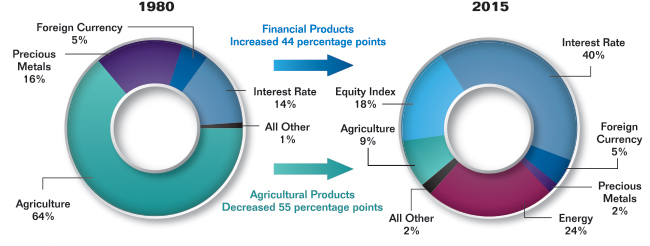
Over a 35 year span, the share of on-exchange commodity futures and option trading activity in the agricultural sector decreased 55 percentage points, while the share of the financial sector commodity futures and option contracts increased 44 percentage points.Electronic integration of cross-border markets and firms, as well as cross-border alliances, mergers and other business activities have transformed the futures markets and firms into a global industry. With the passage of the Dodd-Frank Act, the Commission was tasked with bringing regulatory reform to the swaps marketplace. Swaps, which had not previously been regulated in the United States, formed a collective global trading market valued in the hundreds of trillions of dollars when measured by notional amount.
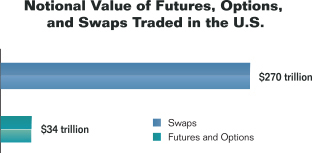
The notional value of the U.S. swaps markets, as reported in the October 30, 2015 CFTC weekly swaps report, is almost eight times larger than the U.S. futures markets the Commission has historically overseen.Generally speaking, a swap is an exchange of one asset or liability for a similar asset or liability for the purpose of, inter alia, shifting risks, where the value of those payments is determined in the future based on some previously agreed measure. With a swap, counterparties agree to exchange future cash flows at regular intervals, with each cash flow calculated on a different (previously agreed-upon) basis. Before the Dodd-Frank Act, swaps were, for the most part, traded over-the-counter (also called bilaterally), which means that swaps were not traded on regulated derivatives exchanges and many were not cleared through DCOs. Swaps are tools for hedging risks associated with, among other things, interest rates, currency fluctuations, and the cost of energy products, such as oil and natural gas. The value of a swap is derived from the value of the underlying asset or rate that serves as the basis for each (or both) legs of the exchange.
For example, two people may agree to swap the cost of a fixed interest rate on a $100,000 mortgage for a variable interest rate on a $100,000 mortgage. Person A agrees to pay a fixed interest rate of five percent to Person B, every month for a year. In exchange, Person B agrees to pay Person A variable interest rate based on the prime rate (currently 3.25 percent) plus 1.75 percent. Because these two interest rates equal each other at the time the swap is agreed, neither person owes anything to the other. If, however, the prime rate rises, then Person B will owe more money to Person A. Thus, at the time the swap is agreed, Person A is assuming interest rates will rise, whereas Person B is hoping interest rates will fall.
In normal times, these markets create substantial, but largely unseen, benefits for American families. During the recent financial crisis, however, their effect was just the opposite. It was during the financial crisis that many Americans first heard the word derivatives. That was because over-the-counter swaps accelerated and intensified the crisis. The government was then required to take actions that today still stagger the imagination: for example, largely because of excessive swap risk, the government committed $182 billion to prevent the collapse of a single company—AIG—because its failure at that time, in those circumstances, could have caused our economy to fall into another Great Depression.
It is hard for most Americans to fathom how this could have happened. While derivatives were just one of many things that caused or contributed to the crisis, the structure of some of these products created significant risk in an economic downturn. In addition, the extensive, bilateral transactions between the largest banks and other institutions meant that trouble at one institution could cascade quickly through the financial system like a waterfall. The opaque nature of this market meant that regulators did not know the level of exposure that any one institution or the financial system faced.
-
CFTC Regulatory Landscape – Part 2
Dodd-Frank Act: Enhanced Regulatory Environment
On July 21, 2010, the Dodd-Frank Act was enacted and the CEA was significantly amended to establish a comprehensive new regulatory framework to include swaps, as well as enhanced authorities over historically regulated entities.
The purpose of the derivatives provisions of the Dodd-Frank Act was to implement the commitments made by the United States at the G20 summit in Pittsburgh in 2009. The members of the G20 made four commitments: 1) require regulatory oversight of the major market players; 2) require clearing of standardized transactions through regulated DCOs; 3) require more transparent trading of standardized transactions; and 4) require regular reporting so that regulators and market participants would have an accurate picture of what is going on in the market.
Regulatory Oversight
Five years ago, swap dealers (SDs) had no specific requirement to their swap dealing activity. The first of the major directives Congress gave to the CFTC was to create a framework for the registration and regulation of SDs and major swap participants (MSPs). The Commission has done this. As of September 30, 2015, there are 104 SDs and one MSP provisionally registered with the CFTC.
Registered Professionals
as of September 30, 2015Type of Registered Professional Number Associated Persons (AP) (Sales People) 56,003 Commodity Pool Operators (CPOs) 1,719 Commodity Trading Advisors (CTAs) 2,377 Floor Brokers (FBs) 4,191 Floor Traders (FTs) 764 Futures Commission Merchants (FCMs)2 71 Introducing Brokers (IBs) 1,306 Major Swap Participant (MSP) 1 Retail Foreign Exchange Dealer (RFEDs) 5 Swap Dealer (SDs) 104 TOTAL 66,541 Companies and individuals who handle customer funds, solicit or accept orders, or give trained advice must apply for CFTC registration through the National Futures Association (NFA), a self-regulatory organization (SRO) with delegated oversight authority from the Commission. The Commission regulates the activities of over 66,000 registrants. The Commission has adopted rules requiring strong risk management by SDs and MSPs. It will be carrying out periodic examinations to assess risk and compliance at these registered entities. The new framework requires registered SDs and MSPs to comply with various business conduct requirements. These include strong standards for documentation and confirmation of transactions, as well as dispute resolution processes. The regulations include requirements to reduce risk of multiple transactions through what is known as portfolio reconciliation and portfolio compression. In addition, SDs are required to make sure their counterparties are eligible to enter into swaps, and to make appropriate disclosures to those counterparties of risks and conflicts of interest.
As directed by Congress, the Commission has worked with the U.S. Securities and Exchange Commission (SEC), other U.S. regulators, and our international counterparts to establish this framework. The Commission will continue to work with them to achieve as much consistency as possible. It will also look to make sure these rules work to achieve their objectives, and fine-tune them as needed where they do not.
Clearing
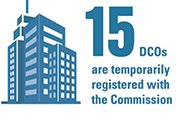
A second directive of the Dodd-Frank Act was to require clearing of standardized transactions at DCOs. DCOs reduce the risk that one market participant’s failure could adversely impact other market participants or the public, by standing in between the two original counterparties to a transaction—as the buyer to every seller and the seller to every buyer—and maintaining financial resources to cover potential defaults. DCO’s value positions daily and require parties to post adequate margin on a regular basis. “Margin” is the collateral that holders of financial instruments have to deposit with DCOs to cover some or all of the risk of the positions. Collateral must be in the form of cash or highly liquid securities.
The use of DCOs in financial markets is commonplace and has been around for over one hundred years. The idea is simple: if many participants trade standardized products on a regular basis, the tangled, hidden web created by thousands of private two-way trades can be replaced with a more transparent and orderly structure, like the spokes of a wheel, with the DCO at the center interacting with market participants. The DCO is required to monitor the overall risk and positions of each participant.
The CFTC was the first of the G-20 nations’ regulators to implement a regime for mandatory clearing of swaps. The Commission has required clearing for certain types of interest rate swaps denominated in U.S. dollars, Euros, Pounds and Yen, as well as CDS on certain North American and European indices. Based on CFTC analysis of data reported to SDRs, as of September 2015, measured by notional value, 75 percent of all outstanding transactions were cleared. This is compared to estimates by the International Swaps and Derivatives Association (ISDA) of only 16 percent in December 2007. With regard to index CDS, most new transactions are being cleared—85 percent of notional value, as of September 2015.
The CFTC rules for clearing swaps were patterned after the successful regulatory framework used for many years in the futures market. The Commission requires that clearing occurs through CFTC-registered or exempt DCOs that meet certain standards—a comprehensive set of core principles and regulations that ensures each DCO is appropriately managing the risk of its members, and monitoring its members for compliance with important rules.
Of course, central clearing by itself is not a panacea. DCOs do not eliminate the risks inherent in the swaps market. The Commission must therefore be vigilant. It must do all it can to ensure that DCOs have financial resources, robust risk management tools, systems that minimize operational risk, and all the necessary standards and safeguards consistent with the core principles to operate in a fair, transparent and efficient manner. DCOs must also have tools in place to address a wide range of situations that may arise if a clearing member defaults. They must develop plans to deal with losses to the DCO in non-default situations. The Commission must also make sure that DCO contingency planning to deal with operational events, such as cyber-attacks, is sufficient.
Trading
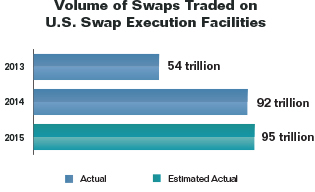
Swap execution facilities, a new type of CFTC-regulated platform for trading swaps, began operating on October 2, 2013. The annualized volume of 54 trillion in 2013 is a partial year based on actual trading volume between October 2 and December 31, 2013.
The third area for reform under the Dodd-Frank Act was to require more transparent trading of standardized derivatives products. In the Dodd-Frank Act, Congress provided that certain swaps must be traded on a SEF or a designated contract market (DCM) exchange. The Dodd-Frank Act defined a SEF as “a trading system or platform in which multiple participants have the ability to execute or trade swaps by accepting bids and offers made by multiple participants.” The trading requirement was designed to facilitate a more open, transparent and competitive marketplace, benefiting, among others, commercial end-users seeking to lock in a price or hedge risk.
The CFTC finalized its rules for SEFs in June 2013. Twenty-three SEFs have been temporarily registered with the CFTC, and one application is pending. These SEFs are diverse, but each will be required to operate in accordance with the same core principles. These core principles provide a framework that includes obligations to establish and enforce rules, as well as policies and procedures that enable transparent and efficient trading. SEFs must make trading information publicly available, put into place system safeguards, and maintain financial, operational and managerial resources to discharge their responsibilities.
Trading on SEFs began in October 2013. As of February 2014, specified interest rate swaps and CDSs were required to be traded on a SEF or other regulated exchange. As of July 2015, 60 percent of client trading by notional volume is now electronic, up from nine percent in 2010. Notional value executed on SEFs has generally been in excess of $1 trillion monthly. It is important to remember that trading of swaps on SEFs is still new. SEFs are still developing best practices under the new regulatory regime. The new technologies that SEF trading requires are likewise being refined. Additionally, other jurisdictions have not yet implemented trading mandates, which has slowed the development of cross-border platforms. There will be issues as SEF trading continues to mature. The Commission will need to work through these to fully achieve the goals of efficiency and transparency SEFs are meant to provide.
Data Reporting
The fourth G20 reform commitment implemented by the Dodd-Frank Act was to require ongoing reporting of swap activity. Having rules that require oversight, clearing, and transparent trading is not enough. The Commission must have an accurate, ongoing picture of what is going on in the marketplace to achieve greater transparency and to address potential systemic risk. Title VII of the Dodd-Frank Act assigns the responsibility for collecting and maintaining swap data to SDRs, a new type of entity necessitated by these reforms. All swaps, whether cleared or uncleared, must be reported to SDRs. There are currently four SDRs that are provisionally registered with the CFTC.
The collection and public dissemination of swap data by SDRs helps regulators and the public. It provides regulators with information that can facilitate informed oversight and surveillance of the market and implementation of our statutory responsibilities. Dissemination, especially in real-time, also provides the public with information that can contribute to price discovery and market efficiency. While the Commission has accomplished a lot, much work remains. The task of collecting and analyzing data concerning this marketplace requires intensely collaborative and technical work by industry and the agency’s staff. Going forward, it must continue to be one of the CFTC’s chief priorities.
There are three general areas of activity. The CFTC must have data reporting rules and standards that are specific and clear, and that are harmonized as much as possible across jurisdictions. The Commission is leading the international effort in this area. It is an enormous task that will take time. The Commission must also make sure the SDRs collect, maintain, and publicly disseminate data in the manner that supports effective market oversight and transparency. Finally, market participants must live up to their reporting obligations. Ultimately, the market participants bear the responsibility to make sure that the data is accurate and reported promptly.
Guiding Principles
A few core principles must motivate the Commission’s work in implementing the Dodd-Frank Act. The first is that the CFTC must never forget the cost of the financial crisis to American families, and it must do all it can to address the causes of that crisis in a responsible way. The second is that the United States has the best financial markets in the world. They are the strongest, most dynamic, most innovative, most competitive and transparent. They have been a significant engine of U.S. economic growth and prosperity. The Commission’s work should strengthen U.S. markets and enhance those qualities in a way that does not place unnecessary burdens on the dynamic and innovative capacity of the industry.
2 Includes FCMs registered as RFEDs. (back to text)
Forward Looking
Forward Looking – Future Business Trends and Events presents the evolving industry trends and their implications for CFTC during FY 2015.
-
Evolving Industry Trends and Their Implications for CFTC – Part 1
The market participants (the industry) under CFTC jurisdiction continue to change how they conduct business in order to comply with regulatory responsibilities and to maximize opportunities. Industry continues to shift its operating model due to other environmental influences, such as global prudential and other regulatory framework, macro-economic, and technology trends. As industry continues to evolve, the CFTC must have the ability to make accompanying changes across all components of its operations.
This understanding is critical to the Commission’s ability to appropriately regulate industry of today and tomorrow.
Swap Markets are Increasingly Operating under the Dodd-Frank Regulatory Framework
By the end of FY 2016, participants in the swaps market under CFTC jurisdiction will be registered and operating under the framework established by the Dodd-Frank Act. The low-tech, high-touch bilateral voice transactions era for swaps trading will be increasingly replaced by trading on regulated platforms, central clearing and real-time trade reporting as provided for in the Dodd-Frank Act. Much of the regulatory uncertainty for these market participants will have been lifted, and while phasing and fine-tuning of rules will be ongoing, the marketplace will be increasingly trading, settling, and reporting swaps, and reaping the benefits of risk-mitigated hedging strategies. CFTC resources will shift largely from a rule-writing focus, through a period of intense interpretative guidance development, moving towards an operational stance that will emphasize compliance, risk management, monitoring and further refinement and improvement to the Commission’s regulatory framework.
Growth in Clearing through DCOs, New Requirements for Uncleared Swaps, and Monitoring DCOs Reduces Swaps-Related Risks

Fundamental to the Dodd-Frank Act were heightened risk management requirements for DCOs and swap counterparties. Market participants (mainly dealers) began moving to central clearing of standardized swaps prior to the issuance of the CFTC’s mandatory clearing determination for interest rate swaps and CDS, reducing credit risk between counterparties.
Under the Dodd-Frank Act, clearing members and swap customers are required to pay variation margin through their FCMs to avoid the accumulation of large gain and/or loss obligations. In addition, clearing members and swap customers are required to post initial margin to cover the potential future exposure of their positions in the event of default. Complementary margin requirements have been proposed for uncleared swaps for SDs and MSPs subject to the CFTC’s jurisdiction (i.e., non-bank SDs and MSPs). In addition to posting margin, non-bank SDs and MSPs are required to hold minimum levels of capital under Section 731 of the Dodd-Frank Act. These capital and margin requirements are intended to reduce swaps-related systemic risk in the global financial system and to encourage clearing. As DCOs offer new swaps for clearing, the CFTC will evaluate whether such swaps should be required to be cleared, as well as assess the ability of the DCO to properly manage the risk of clearing those swaps.
The CFTC faces a number of challenges with its new jurisdiction related to swaps. Foremost, the notional value of cleared swaps is estimated to be on the order of a factor of almost eight times that of futures and options. This fact alone demonstrates the need for the CFTC to apply significant staffing resources to monitor the risk surveillance activities of DCOs, FCMs, and swaps market participants, in addition to maintaining (if not increasing) surveillance of futures and options market participants. FCMs and end-users are keenly aware of the importance of DCOs, and of their exposure to loss if DCOs fail to properly manage risk, and thus the CFTC will focus on supervision of DCOs to ensure their reliable and safe operation.
The movement of swaps to a cleared environment has created greater transparency in the market but has also shifted significant new levels of counterparty risk to DCOs. As more swap activity migrates to clearing the DCOs are holding substantially more collateral that has been deposited by market participants. There is a need to perform examinations of DCOs to evaluate the resources and capabilities of the DCO to monitor and control their financial and operational risks.
Clearing Firms and Customers Trade the Same Asset Class at Multiple DCOs
Firms and customers often clear the same asset classes at multiple DCOs. Each DCO’s view is limited to the position it clears, while the Commission has the unique perspective of being able to analyze positions and the risks that they pose across DCOs. The Commission has to ensure it has the data and tools necessary to evaluate the risk of these positions. The Commission should be able to ascertain if the positions at the multiple DCOs increase or offset risk. The Commission must further be able to determine if the firm or customer has the resources to cover the potential losses at each DCO and not require the gains at one DCO to pay the losses at the others.
Aggregating Cleared Swaps and Futures Risk
Many large swap accounts (firms and customers) also clear large futures positions. In many cases, the swaps and futures are cleared at the same firm. The Commission has to ensure it has the procedures in place to first identify these accounts. Then secondly, the Commission has to ensure it has the software and information necessary to determine if the different asset classes increase or decrease risk. DCOs now and increasing in the future are offering cross-margin programs between asset classes. The Commission has to ensure it receives all position and account information for accounts in these programs. The Commission then has to have the software and expertise necessary to review and understand the risk and margin offsets present in the program.
New Regulatory Environment Driving Innovations in Derivatives Markets
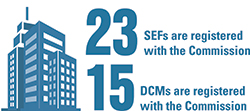
The Commission will also continue to oversee the activities of existing SEFs and DCMs to ensure compliance with Commission regulations and the CEA. In addition, the Commission expects to receive new applications for SEF registration and DCM designation. The industry is responding quickly to the competitive opportunities engendered by the shifting regulatory landscape—the introduction of futures contracts by DCMs that are economically equivalent to standardized swaps is one such example. Innovation in the industry, which is likely to increase in pace with the addition of SEFs, will continue to add complexity in ways currently unanticipated. For example, the Commission is seeing new methods for executing transactions that were not proposed in previous years. While these changes will impact all of the CFTC mission activities, the near-term impacts will fall most heavily on the registration, product review, examinations, enforcement, and economic analysis mission activities.
-
Evolving Industry Trends and Their Implications for CFTC – Part 2
Exponential Growth in Data Must be Acquired, Validated, Warehoused, and Analyzed to Fulfill the Commission’s Regulatory Responsibilities
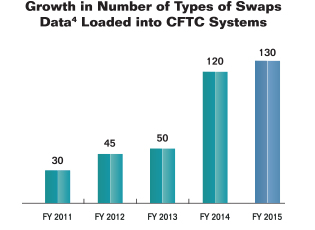
The CFTC receives data from more than 200 new entities, such as clearing members, SDs, DCO’s, large banks and traders in futures and options markets, SDRs and SEFs, which did not previously provide data prior to the Dodd-Frank Act. The amount of data received and loaded into CFTC systems over five years has more than quadrupled. CFTC currently has plans to receive automated data from up to 6,000 new reporting entities in the coming years. The 6,000 entities represent market participants that will be required to submit Form 405 reports electronically once the Ownership and Control Reporting (OCR) rule is fully implemented.
The Commission continues to enhance its software and automated tools to accommodate its enhanced surveillance responsibilities and access to data, including that generated by the swap data reporting rules, enhanced customer protection rules, chief compliance officer annual reports, risk exposure reports, Volcker Rule3, other regulatory changes, increasing number of participants, and increasing number and complexity of data sources relevant to surveillance. The technology (data and processes) required for surveillance of swaps markets differs from that required for futures and options markets, and differs across asset classes. In addition, the ability to view risk across asset classes and in combination with futures is an overarching requirement that must also be automated and the Commission must continue to work closely with the SDRs, SROs and other Federal and international regulators (as appropriate) to harmonize how this data is recorded, organized, and stored. In response to the influx of new types of data from new and existing registrants, the CFTC must build its own information infrastructure and analytical capabilities to support its responsibilities as a first line regulator.
The CFTC is required to perform a comprehensive function that cannot be done by any single SRO and needs to see data from all industry participants in the swaps and futures markets. In response to the influx of new types of data from new and existing registrants, the CFTC must continue to enhance and adjust its information infrastructure and analytical capabilities to support its responsibilities as a first line regulator. Only by providing advanced tools and enriched data for staff to connect, analyze, and aggregate data can the Commission apply its unique view of the derivatives market toward effective market and risk surveillance. With each additional set of data collected there are data, technology, and usage requirements:
- Defining data standards (e.g., FIXML, FpML) to collect data;
- Architecting data repositories to facilitate data loading and integration;
- Developing software to load new data;
- Developing data validation mechanisms to report errors and metrics to submitters;
- Providing operations support to facilitate timely submission of data;
- Developing data profiles on data submissions, submitters, markets, etc. (not currently done); and
- Analyzing data in a wide variety of ways to support mission functions.
The Commission will continue to adapt its data architecture and data management practices to manage the exponential growth in the size and complexity of mission data and facilitate continuous improvements in data quality and the ability to isolate anomalous market activity and complex financial and systemic risk.
There is heightened attention, both domestically and internationally, to cyber-security and the risk of cyber-attacks against DCOs, DCMs, SEFs, and the Commission itself. The CFTC will utilize and collaborate with FS-ISAC, ChicagoFIRST, CYWATCH™, and NIST and other regulatory bodies to ensure that current information and trends can be used when monitoring compliance with the systems safeguards core principle applicable to registered entities. The Commission also continues to increase its own cyber-security protections over the data collected from market participants for surveillance and enforcement.
Comparison of Reported Public Sector and Financial Services Sector6 Cyber-Security Breaches7 Year Confirmed
BreachesRecords
CompromisedPublic Sector Financial
Services Sector2010 75 4 million 4% 22% 2011 855 174 million 7% 28% 2012 621 44 million 5% 8.1% 2013 1,367 200 million 13% 34% 2014 2,122 700 million 14% 13% As a Federal government agency, the CFTC is a public sector entity that provides regulatory oversight for parts of the financial services sector, or marketplace. Both sectors are a magnet for those looking for economic advantage or wishing harm to the Federal government, therefore the Commission’s due diligence in ensuring systems safeguards for CFTC-registered entities and its own cyber-security protections is critical.
3 The Volcker Rule refers to refers to § 619 (12 U.S.C. § 1851) of the Dodd-Frank Act, originally proposed by American economist and former United States Federal Reserve Chairman Paul Volcker to restrict U.S. banks from making certain kinds of speculative investments that do not benefit their customers. Volcker argued that such speculative activity played a key role in the financial crisis of 2007–2010. The rule is often referred to as a ban on proprietary trading by commercial banks, whereby deposits are used to trade on the bank’s own accounts, although a number of exceptions to this ban were included in the Dodd-Frank law. (back to text)
4 Swaps data include Part 20 and Part 39 interim records reporting files, additional by-rule development, Part 45 swaps data reporting, OCR-ownership and control reporting, and Volcker data. (back to text)
5 CFTC Form 40, Statement of Reporting Trader, is a reporting requirement for every person that holds a reportable position in accordance to Section 1804 of the CEA. The information requested is used generally in the Commission’s market surveillance activities to provide information concerning the size and composition of the commodity futures or option markets, and to permit the Commission to monitor and enforce the speculative position limits that have been established. The complete listing of routine uses, in accordance with the Privacy Act, 5 U.S.C. §522a, and the Commission’s rules thereunder, 17 CFR Part 146, of the information contained in these records is found in the Commission’s annual notice of its system of records. (back to text)
6 Public sector is defined as Federal government entities and the financial services sector encompasses a broad range of businesses that manage money, including credit unions, banks, credit-card companies, insurance companies, accountancy companies, consumer-finance companies, stock brokerages, investment funds and some government sponsored enterprises. (back to text)
7 Data Source: Verizon Data Breach Investigation Reports 2010–2014, http://www.verizonenterprise.com/dbir. The 2015 Cyber Security Breach report has not been published, to date. (back to text)
-
Evolving Industry Trends and Their Implications for CFTC – Part 3
Growth and Complexity of the Market the Commission Enforces
The CFTC will continue to use the resources it has to engage in robust enforcement, including using its anti-manipulation authority for the futures and swaps markets and the statutory prohibition on disruptive trading, including the provision outlawing “spoofing”. The Commission continues to investigate cases of high-frequency trading and spoofing tactics, however the analytics required to interpret the “layering algorithms” are an issue, particularly given the resource-intensive nature of the matters. Without adequate resources, the Commission may be limited in its ability to prevent fraud from use of algorithms, high-frequency trading, and other automated trading.
Growth and Complexity of the Markets and Schemes
The CFTC continues to devote significant resources to investigate and prosecute trading schemes that threaten the integrity of the markets and place market participants at risk. With the increase of markets and products that the Commission oversees and growing complexity and interrelated nature of the markets, the CFTC will see a commensurate increase in the complexity of its investigations of manipulative, fraudulent and disruptive trading practices. For example, while the Commission continues to investigate cases of spoofing tactics by high-frequency traders and other market participants, the Commission needs to ensure it has the requisite expert capabilities and analytical resources to efficiently and effectively investigate.
Maintaining Integrity of Benchmarks
The integrity of benchmarks remains a priority for the Commission. Over the last two years, the Commission has imposed civil monetary penalties of $4.7 billion for manipulation and attempted manipulation of global benchmark rates, including: $1.9 billion for misconduct relating to foreign exchange benchmarks; and over $2.8 billion for misconduct relating to International Swaps and Derivatives Association Fix (ISDAFIX), London Interbank Offered Rate (LIBOR), Euro Interbank Offered Rate (Euribor), and other interest rate benchmarks. These benchmarks are an essential valuation tool for thousands upon thousands of derivatives across financial markets, including: options on interest rate swaps, or swaptions; cross-currency swaps; foreign exchange swaps; spot transactions; forwards; options; and futures. These investigations are global in nature and continue to require a significant allocation of enforcement resources.
Protecting Customers from Fraud
Anti-fraud enforcement remains a core commitment of the CFTC’s enforcement program. During FY 2015, the Commission prosecuted wrongdoers for a wide range of fraudulent schemes, including Ponzi schemes that preyed upon the retail public’s hopes to participate in foreign exchange (forex) trading, precious metals speculation, and commodity pools. The Commission’s experience with fraudsters is that they gravitate towards, and flourish in, financial markets that are not “policed.” Therefore, the Commission must continue to devote significant resources to “walk the beat” of the financial markets within its jurisdiction and protect the retail public that wants to participate in them.
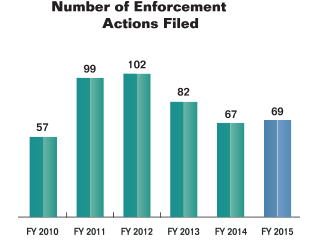
The CFTC utilizes every tool at its disposal to detect and deter illegitimate market forces. Through enforcement action, the Commission preserves market integrity and protects market users, demonstrating that the Commission has significant authority and intends to use it.
Ensuring that Markets, Firms and Participants Meet their Obligations
In protecting the markets and market participants, the Commission engages in investigations and takes enforcement action, when necessary, to make sure that firms maintain their financial integrity and that markets, firms and significant market participants fulfill their regulatory obligations, including reporting obligations. Commission registrants are required to meet standards for their capitalization and handling of funds, which standards are intended to safeguard against market disruption and abuse from imprudent practices or intentional misconduct and to protect customers. The reporting requirements for markets, firms and significant market participants are essential to the CFTC’s ability to conduct effective surveillance of the futures and derivatives markets that it regulates. With the Dodd-Frank Act’s expansion of the Commission’s responsibility, the Commission is doing all it can with its available resources to ensure that the markets, firms and significant market participants in the trillion dollar swaps marketplace uphold these essential obligations.
8 The sanctions ordered represent civil monetary penalties, disgorgement, and restitution. (back to text)
Performance Highlights
The Performance Highlights present a high-level summary of CFTC's FY 2015 performance. See below for a summary of performance results, strategic goals and key results, and four strategic goals.
-
Summary of Performance Results9
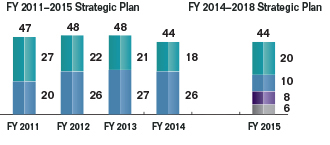
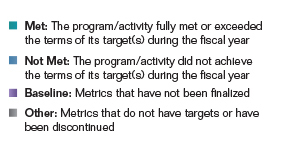
The bar graph above presents the ratings distribution for performance results reported from FYs 2011 through 2015. Results prior to FY 2015 are based on targets contained in the FY 2011–2015 Strategic Plan. FY 2015 results are based on targets contained in the CFTC’s new Strategic Plan, which covers FY 2014–2018. Although results achieved under the two Strategic Plans are not directly comparable, results from years prior to FY 2015 are presented to provide a historical context to the current performance data.
The following, in chronological order, are the results for the past five years:
- In FY 2011, CFTC published the FY 2011–2015 Strategic Plan introducing 54 performance metrics; however, most of FY 2011 was spent under a continuing resolution, making it challenging to fund mission critical activities, which resulted in 27 of the 54 targets being met. In addition, seven performance measures were considered “Not Applicable” during FY 2011 either because they were dependent on completion of rules related to the Dodd-Frank Act or remained in development from the onset of the Strategic Plan. These seven “Not Applicable” measures were not included in the Summary of Performance Results which brings the total number of performance metrics to 47 for FY 2011.
- In FY 2012, results declined to 22 targets being met. Progress was hampered in many areas by significant resource deficiencies and reallocations as the Commission focused on writing new rules required under the Dodd-Frank Act.
- In FY 2013, the Commission was not provided with the commensurate increase in budget authority to oversee the markets and market participants. These constraints, which were exacerbated by the FY 2013 budget sequestration, limited the effectiveness of the Commission in carrying out its mission, leading to 21 targets met by year end.
- In FY 2014, the Commission demonstrated some progress toward achievement of the Commission’s mission and strategic goals. However, in many key areas, such as risk-based examinations of entities, including clearinghouses, exchanges, and swap dealers that the Commission oversees, progress was limited by resource constraints, ending the year with 18 targets met.
- In early FY 2015, the CFTC published a new Strategic Plan that spans 2014–2018, with a new set of 44 metrics. At the end of FY 2015, eight performance metrics are “baseline” and thus do not have annual targets. These baseline metrics are being evaluated in FY 2016 with the intent of creating a basis for future measurement. Four of the six “other” metrics are related to external factors with activities that are worth tracking but have no targets; while two of the six “other” metrics were discontinued during FY 2015. Of the remaining 30 measurable metrics, 20 met the FY 2015 targets.
9 Expired performance measures were under the FY 2011–2015 Strategic Plan. (back to text)
-
Strategic Goals and Key Results
The selected accomplishments described below demonstrate progress made in FY 2015 toward the achievement of the Commission’s mission and strategic goals. In order to provide better and more frequent assessments to leadership, the CFTC is monitoring the progress of these performance goals on a quarterly basis.
The Commission’s FY 2015 Annual Performance Report and FY 2017 Agency Performance Plan, issued in February 2016 as part of its Congressional Budget Justification in conjunction with the President’s Budget, presents more detailed analysis of the following performance results.
-
Strategic Goal One – Market Integrity and Transparency
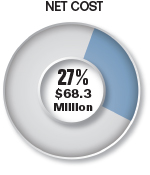
2015 Accomplishments
- Opened the OPERA portal through which exchanges electronically file submissions directly with the Commission. DCMs, SEFs, and SDRs made 2,140 product and rule amending filings. Nearly 96 percent of those submissions were filed through OPERA, which automatically routes submissions to relevant staff and reduces staff time spent on data entry tasks.
- Completed reviews of 634 new product certifications, 944 rule filings, 10 foreign security index certifications, and one foreign board of trade no-action request.
- Continued its work to implement OCR. The Commission expects that identification and data-series linking will begin in 2016 when the OCR data will begin to be collected. Over time, the CFTC anticipates identifying 85 percent of trading volume in approximately 90 percent of futures products, thereby enabling 100 percent of matching of parties present in both datasets.
-
Strategic Goal Two – Financial Integrity and Avoidance of Systemic Risk
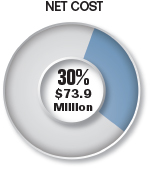
2015 Accomplishments
- Monitored retail forex dealers during the foreign currency volatility event that occurred in January 2015. Staff worked closely with designated SROs and industry participants to ensure that retail forex dealers remained in compliance with Commission capital and other financial requirements, and that retail forex customer deposits held as security deposits by the retail forex dealers were protected.
- Completed annual examinations of two systemically important DCOs. The Commission focused on financial integrity, system safeguards, including cyber-security, and risk management for the examinations.
- Conducted various direct and horizontal limited scope reviews while reviewing over 1,200 financial filings and 1, 700 notices. The new horizontal reviews focused on the liquidity of FCMs, the sufficiency of excess segregation and secured requirements, risk management, and internal controls of FCMs.
-
Strategic Goal Three – Comprehensive Enforcement
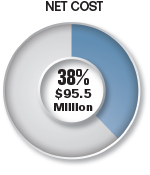
2015 Accomplishments
- Filed 69 new enforcement actions and opened more than 220 new investigations in FY 2015. In addition, the Commission obtained more than $3.2 billion in sanctions, including orders imposing more than $3.1 billion in civil monetary penalties and more than $59 million in restitution and disgorgement.
- Took significant enforcement action in its: spoofing and disruptive trading enforcement, headlined by its “Flash Crash” enforcement action; benchmark rate manipulation cases; actions against bitcoin trading platforms to ensure their compliance with the CEA; and enforcement actions against swaps markets intermediaries to ensure their compliance with reporting obligations, which are critical to the smooth running of the markets and the CFTC’s ability to respond to potential misconduct.
- Developed a communications strategy for the Whistleblower Program, which included 12 public forums and trade shows, such as the Futures Industry Association Expo, and other key activities to inform the public about the assistance and protections available under the Whistleblower Program. In addition, the Whistleblower Office developed and completed training sessions for all Division of Enforcement staff on the responsibility and protocol for handling whistleblower information.
-
Strategic Goal Four – Domestic and International Cooperation and Coordination
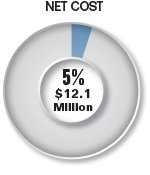
2015 Accomplishments
- Collaborated with U.S. Treasury, U.S. Securities and Exchange Commission, Federal Deposit Insurance Corporation, the Federal Reserve, and the Office of Comptroller of the Currency on setting up the Global Legal Entity Identifier System (GLEIS) including the implementation of the Legal Entity Identifier (LEI) Regulatory Oversight Committee that assist the Commission in the implementation of Part 45 swap data reporting.
- Issued approximately 200 requests for assistance to foreign regulators and received approximately 30 assistance requests from foreign regulators. The information obtained from and exchanged with foreign regulators and domestic government agencies assisted the CFTC in bringing many of its actions in FY 2015, including the “Flash Crash” case brought under the Commission’s new disruptive trading and “spoofing” authority, and the foreign exchange, LIBOR, and ISDAFIX Benchmark Rates cases, and facilitated the filing of many parallel criminal proceedings.
- Handled nearly 300 matters involving joint cooperation with Federal and state criminal and civil authorities, and approximately 90 percent of its major fraud and manipulation cases in FY 2015 involved parallel criminal proceedings.
Financial Highlights
The Financial Highlights present a high-level summary of CFTC's FY 2015 financials. See below for the message from the Chief Financial Officer and other financial highlights including an overview of the financial statements.
-
A Message from the Chief Financial Officer
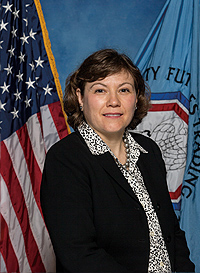
I am honored to join Chairman Massad in presenting the FY 2015 Agency Financial Report for the CFTC. This report provides financial and high-level performance information to the American taxpayer and the Commission’s stakeholders to enable them to understand and evaluate how the Commission accomplishes its mission. This Financial Section includes the Commission’s principal financial statements—Balance Sheets, Statements of Net Cost, Statements of Changes in Net Position, Statements of Budgetary Resources, and Statements of Custodial Activity—as well as accompanying notes that are integral to fully understanding the Commission’s position and operations for FY 2015.
Despite noteworthy progress, for FY 2015 our independent auditor, KPMG LLP, on behalf of the Commission’s Office of the Inspector General, has issued a qualified opinion on our financial statements for FY 2015. In FY 2015, the auditors identified a material weakness in internal controls over financial reporting related to the recording of lease obligations that dates back to the inception of CFTC’s leases.
During FY 2015, the GAO requested information on the Commission’s views regarding various legal issues involving the CFTC’s leases, including CFTC’s practice for recording obligations arising under the agency’s current leases for office space in Washington, D.C., Chicago, New York, and Kansas City. The CFTC was granted independent leasing authority in 1974, and received authority to expend appropriated funds on multiple year leases in FY 1981. The CFTC’s historical practice has been to obligate only the annual portion of lease payments due each fiscal year. As a result of the CFTC’s review of information gathered during the course of responding to the GAO inquiry, the Commission concluded that its historical practice for recording lease obligations may be inconsistent with OMB Circular A-11, Preparation, Submission and Execution of the Budget; the recording statute in 31 U.S.C. § 1501 (a)(1); and previous GAO decisions. The GAO is currently reviewing the matter and the agency expects an opinion to be issued during FY 2016. As a result of the potential findings of the anticipated GAO opinion, it is reasonably possible that an unfunded obligation, covering all potential future payments agreed to under current leases, will need to be recognized and the Commission has disclosed this potential obligation in the notes to its financial statements. Once the GAO opinion is received, the agency will address the appropriate accounting treatment of this matter.
Since FY 2007, the CFTC has leveraged a financial management systems platform operated by the U.S. Department of Transportation’s (DOT) Enterprise Services Center (ESC), an Office of Management and Budget (OMB) designated financial management service provider. As a result, the CFTC is able to accumulate, analyze, and present reliable financial information, and provide reliable, timely information for managing current operations and timely reporting of financial information to central agencies. The Commission’s financial management systems strategy for FY 2016 includes continued monitoring and oversight of the financial management system (DELPHI) operated by its shared service provider; no major upgrades are planned for the near future.
The Commission is committed to maintaining strong internal controls over operations. We will continue to focus efforts to improve the efficiency and effectiveness of agency operations and strive to ensure that the Commission will be well-positioned to respond to additional challenges as they arise.

Mary Jean Buhler
Chief Financial Officer
January 15, 2016 -
Summary of Audit and Management Assurances
Summary of FY 2015 Financial Statement Audit
Summary of Financial Statement Audit Audit Opinion: Qualified Restatement: No Material Weakness Beginning Balance New Resolved Consolidated Ending Balance 0 1 1 Summary of Management Assurances
Effectiveness of Internal Control over Financial Reporting (FMFIA § 2) Statement of Assurance: Qualified Material Weakness Beginning Balance New Resolved Consolidated Reassessed Ending Balance 0 1 1 Effectiveness of Internal Control over Operations (FMFIA § 2) Statement of Assurance: Unqualified Material Weakness Beginning Balance New Resolved Consolidated Reassessed Ending Balance 0 0 0 Conformance with Financial Management System Requirements (FMFIA § 4) Statement of Assurance: Systems conform to financial management system requirements Non-Conformance Beginning Balance New Resolved Consolidated Reassessed Ending Balance 0 0 0
DEFINITION OF TERMS
Beginning Balance: The beginning balance will agree with the ending balance if material weaknesses from the prior year.
New: The total number of material weaknesses that have been identified during the current year.
Resolved: The total number of material weaknesses that have dropped below the level of materiality in the current year.
Consolidation: The combining of two or more findings.
Reassessed: The removal of any finding not attributable to corrective action.
Ending Balance: The agency’s year-end balance.
-
5-Year Financial Summary
The table below presents trend information for each major component of the Commission’s balance sheets and statements of net cost for FY 2011 through FY 2015. The table is immediately followed by a discussion and analysis of the Commission’s major financial highlights for FY 2015.
CFTC Financial Highlights Highlights 2015 2014 2013 2012 2011 Condensed Balance Sheet Data Fund Balance with Treasury $67,246,060 $47,070,343 $36,467,970 $82,557,690 $81,785,717 Investments 263,000,000 270,000,000 95,000,000 77,135,901 – Accounts Receivable 18,614 11,112 13,252 20,976 59,226 Prepayments 2,473,459 1,712,871 1,541,681 1,803,497 1,109,626 Custodial Receivables, Net 4,696,176 4,218,788 69,744,626 4,140,347 2,574,173 General Property, Plant, and Equipment, Net 50,358,266 54,464,549 58,251,172 53,410,435 42,346,895 Deferred Costs 28,487 64,201 220,953 1,234,223 6,254,873 TOTAL ASSETS $387,821,062 $377,541,864 $261,239,654 $220,303,069 $134,130,510 Accounts Payable $8,607,890 $5,483,221 $5,092,410 $7,217,772 $7,092,349 FECA Liabilities 498,101 549,734 596,353 764,243 528,512 Accrued Payroll and Annual Leave 15,004,112 13,007,491 11,651,586 16,477,676 15,464,338 Custodial Liabilities 4,696,176 4,218,788 69,744,626 4,140,347 2,574,173 Depost Fund Liabilities 179,806 134,683 83,997 77,098 57,127 Deferred Lease Liabilities 25,673,457 25,961,973 25,241,114 24,808,042 21,974,782 Contingent Liabilities 300,000 85,000 – – – Other 22,397 11,699 19,600 19,050 19,649 TOTAL LIABILITIES $54,981,939 $49,452,589 $112,429,686 $53,504,228 $47,710,930 Unexpended Appropriations – All Other Funds 50,997,602 35,420,980 25,006,039 46,349,473 44,666,156 Cumulative Results of Operations – Funds from Dedicated Collections 267,612,410 274,315,312 99,904,291 99,996,749 23,755,000 Cumulative Results of Operations – All Other Funds 14,229,111 18,352,983 23,899,638 20,452,619 17,998,424 Total Net Position 332,839,123 328,089,275 148,809,968 166,798,841 86,419,580 TOTAL LIABILITIES AND NET POSITION $387,821,062 $377,541,864 $261,239,654 $220,303,069 $134,130,510 Condensed Statements of Net Cost Gross Costs $249,861,126 $217,450,008 $218,155,538 $207,618,265 $187,648,360 Earned Revenue (53,074) (31,375) (49,483) (227,504) (88,720) TOTAL NET COST OF OPERATIONS $249,808,052 $217,418,633 $218,106,055 $207,390,761 $187,559,640 Net Cost of Operations by Strategic Goal10 Goal One – Market Integrity and Transparency $68,322,502 N/A N/A N/A N/A Goal Two – Financial Integrity and Avoidance of Systemic Risk 73,918,203 N/A N/A N/A N/A Goal Three – Comprehensive Enforcement 95,501,618 N/A N/A N/A N/A Goal Four – Domestic and International Cooperation and Coordination 12,065,729 N/A N/A N/A N/A
Goal One – Market Integrity
N/A
$56,746,263
$62,225,658
$59,168,584
$48,390,387Goal Two – Clearing Integrity N/A 51,963,054 57,470,946 54,647,465 43,701,396 Goal Three – Robust Enforcement N/A 71,530,730 64,123,179 60,972,883 61,144,442 Goal Four – Cross-Border Cooperation N/A 11,740,606 7,306,553 6,947,591 8,440,184 Goal Five – Organizational and Management Excellence N/A 25,437,980 26,979,719 25,654,238 25,883,231 $249,808,052 $217,418,633 $218,106,055 $207,390,761 $187,559,640 10 In FY 2015, the CFTC issued its FY 2014–2018 Strategic Plan. With this plan, the Commission changed Strategic Goal Five, Organizational and Management Excellence, into Management Objectives. (back to text)
-
Financial Discussion and Analysis
The CFTC prepares annual financial statements in accordance with U.S. generally accepted accounting principles (GAAP) for Federal government entities and subjects the statements to an independent audit.
Management recognizes the need for performance and accountability reporting, and regularly assesses risk factors that could have an impact on the Commission’s ability to effectively report. Improved reporting enables managers to be accountable and supports the concepts of the Government Performance and Results Act (GPRA), which requires the Commission to: 1) establish a strategic plan with programmatic goals and objectives; 2) develop appropriate measurement indicators; and 3) measure performance in achieving those goals.
The financial summary as shown on the preceding page highlights changes in financial position between September 30, 2015, and September 30, 2014. This overview is supplemented with brief descriptions of the nature of each required financial statement and its relevance. Certain significant balances or conditions featured in the graphic presentation are explained in these sections to help clarify their relationship to Commission operations. Readers are encouraged to gain a deeper understanding by reviewing the Commission’s financial statements and notes to the accompanying audit report presented in the Financial Section of this report.
-
Understanding the Financial Statements
The CFTC presents financial statements and notes in accordance with accounting principles generally accepted in the United States of America and in the form and content requirements of OMB Circular A-136, Financial Reporting Requirements, which is revised annually by OMB in coordination with the U.S. Chief Financial Officers Council. The CFTC’s current year and prior year financial statements and notes are presented in a comparative format.
The chart below presents changes in key financial statement line items, as of and for, the fiscal year ended September 30, 2015, compared to September 30, 2014.
Changes in Key Financial Statement Line Items Key Financial Statement Line Items 2015 2014 $ Change % Change Total Assets $387,821,062 $377,541,864 $10,279,198 2.72% Total Liabilities $54,981,939 $49,452,589 $5,529,350 11.18% Total Net Position $332,839,123 $328,089,275 $4,749,848 1.45% Transfers-In/Out Without Reimbursement $– $176,110,604 $(176,110,604) (100.00)% Spending Authority from Offsetting Collections $230,746 $176,261,959 $(176,031,213) (99.87)% Total Budgetary Resources $528,502,937 $496,899,396 $31,603,541 6.36% Apportioned $270,359,908 $13,437,561 $256,922,347 1,911.97% Unapportioned $(558,974) $262,111,560 $(262,670,534) (100.21)% Gross Outlays $(234,914,187) $(204,693,512) $(30,220,675) 14.76% Actual Offsetting Collections $(212,554) $(176,466,655) $176,254,101 (99.88)% Custodial Receivables/Liabilities $4,696,176 $4,218,788 $477,388 11.32% -
Balance Sheet
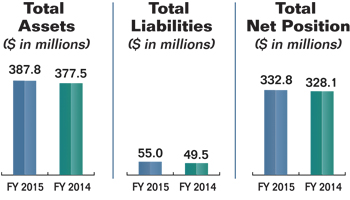
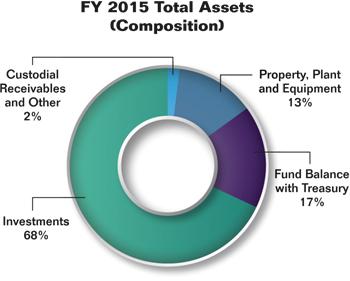
The Balance Sheet presents, as of a specific point in time, the assets and liabilities retained or managed by the Commission. The difference between assets and liabilities represents the net position of the Commission.
Total Assets. For the year ended September 30, 2015, the Balance Sheet reflects total assets of $387.8 million. This is an increase of $10.3 million, or 2.7 percent, over FY 2014. The increase is primarily due to a $20.2 million increase in Fund Balance with Treasury offset by a $7 million decrease in Investments and a $4.1 million decrease in Property, Plant, and Equipment.
The $20.2 million, or 42.9 percent, increase in Fund Balance with Treasury was primarily due to the excess of appropriations of $250 million over appropriations used of $232.3 million due to the timing of cash payments.
The $7.0 million, or 2.6 percent, decrease in Investments is due to the redemption of investments to pay for eligible expenses of the CFTC Customer Protection Fund as no further collections of civil monetary sanctions can be deposited into the fund until the balance of the fund falls below $100 million.
The $4.1 million, or 7.5 percent, decrease in Property, Plant, and Equipment is due to a loss on the disposal of fixed assets of $664 thousand and accumulated depreciation and amortization of fixed assets of $12.7 million in excess of fixed asset purchases of $9.3 million.
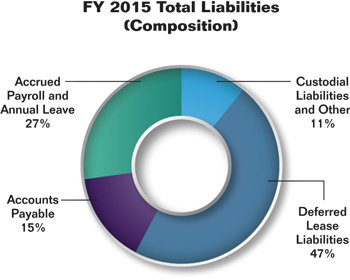
Total Liabilities: For the year ended September 30, 2015, the Balance Sheet reflects total liabilities of $55.0 million. This is an increase of $5.5 million, or 11.2 percent, over FY 2014. The increase is primarily due to increases in Accounts Payable, Accrued Payroll, and Contingent Liabilities of $3.1 million, $1.8 million, and $215 thousand, respectively.
The combined $4.9 million increase in Accounts Payable and Accrued Payroll is reasonable given the $35 million increase in appropriations received in FY 2015, which resulted in an increase in contract obligations and the hiring of approximately 113 employees. In addition, one additional workday was accrued in the year-end payroll accrual in FY 2015.
The $215 thousand, or 252.9 percent, increase in Contingent Liabilities is due to a pending whistleblower payment that is expected to be paid in FY 2016 after the appeal period has ended.
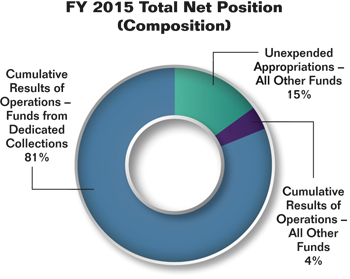
Total Net Position: For the year ended September 30, 2015, the Balance Sheet reflects a total net position of $332.8 million. This is an increase of $4.7 million, or 1.5 percent, over FY 2014. The increase is the result of a $15.6 million increase in Unexpended Appropriations—All Other Funds, offset by decreases of $6.7 million in Cumulative Results of Operations—Funds from Dedicated Collections and $4.1 million in Cumulative Results of Operations—All Other Funds.
The $15.6 million, or 44.0 percent, increase in Unexpended Appropriations—All Other Funds is primarily due to FY 2015 appropriations received of $250 million in excess of appropriations used of $232.3 million due to the timing of actual cash payments, less $2.2 million in canceled funds returned to Treasury.
The $6.7 million, or 2.4 percent, decrease in Cumulative Results of Operations—Funds from Dedicated Collections is due to the CFTC Customer Protection Fund expenses of $6.8 million offset by interest revenue of $58 thousand.
The $4.1 million, or 22.5 percent, decrease in Cumulative Results of Operations – All Other Funds is primarily due to an increase in unfunded liabilities of $62 thousand (e.g., accruals for annual leave and Federal Employees’ Compensation Act expenses and contingent liabilities), net disposal of fixed assets of $664 thousand, and accumulated depreciation and amortization of fixed assets of $12.7 million in excess of fixed asset purchases of $9.3 million.
-
Statement of Net Cost
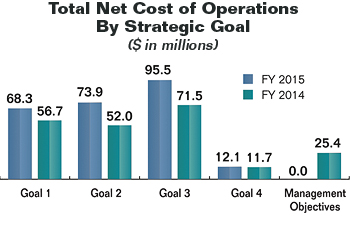
This statement is designed to present the components of the Commission’s net cost of operations. Net cost is the gross cost incurred less any revenues earned from Commission activities. The Commission experienced a $32.4 million, or 14.9 percent, increase in the total net cost of operations during FY 2015.
This overall increase is made up of increases of $15.5 million in payroll, $15.4 million in technology and non-Federal service contracts, $618 thousand in intragovernmental expense, $1.0 million in leases, $1.2 million in travel, and $215 thousand in contingent liabilities. These increases were offset by a decrease of $1.5 million in depreciation. The $15.5 million increase in total payroll costs is primarily the result of an increase in the number of employees by approximately 113, or 17.3 percent. The $18.2 million increase in non-payroll expenses is reasonable given the $35 million, or 16.3 percent, increase in appropriations received in FY 2015.
The Commission implemented a new strategic plan in FY 2015 with slightly different goals; as a result, the FY 2015 and FY 2014 net costs by strategic goal are presented separately rather than comparatively. For FY 2015, the Statement of Net Cost is categorized by the following four strategic goals:
- The focus of Strategic Goal One, Market Integrity and Transparency, is to recognize that derivatives markets provide a means for market users to offset price risks inherent in their businesses and to serve as a public price discovery mechanism. In FY 2015, the net cost of operations for this goal was $68.3 million or 27.4 percent of total net cost of operations.
- The focus of Strategic Goal Two, Financial Integrity and Avoidance of Systemic Risk, is to strive to ensure that Commission-registered DCOs, SDs, MSPs, and FCMs have the financial resources, risk management systems and procedures, internal controls, customer protection systems, and other controls necessary to meet their obligations so as to minimize the risk that the financial difficulty of any of these registrants, or any of their customers has systemic implications. In FY 2015, the net cost of operations for this goal was $73.9 million or 29.6 percent of total net cost of operations.
- Through Strategic Goal Three, Comprehensive Enforcement, the CFTC enforces the CEA and Commission regulations, and works to promote awareness of and compliance with these laws. In FY 2015, the net cost of operations for this goal was $95.5 million or 38.2 percent of total net cost of operations.
- The focus of Strategic Goal Four, Domestic and International Cooperation and Coordination, is on how the Commission interacts with domestic and international regulatory authorities, market participants, and others affected by the Commission’s regulatory policies and practices. In FY 2015, the net cost of operations for this goal was $12.1 million or 4.8 percent of total net cost of operations.
-
Statement of Changes in Net Position
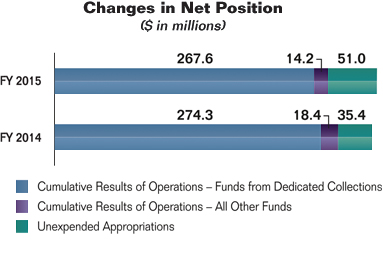
The Statement of Changes in Net Position presents the Commission’s cumulative net results of operations and unexpended appropriations for the fiscal year. The CFTC’s Net Position increased by $4.7 million, or 1.5 percent in FY 2015. As explained in the Total Net Position discussion in the Balance Sheet section, this increase is the result of a $15.6 million increase in Unexpended Appropriations—All Other Funds, offset by decreases of $6.7 million in Cumulative Results of Operations—Funds from Dedicated Collections and $4.1 million in Cumulative Results of Operations—All Other Funds.
The $15.6 million, or 44.0 percent, increase in Unexpended Appropriations—All Other Funds is primarily due to FY 2015 appropriations received of $250 million in excess of appropriations used of $232.3 million due to the timing of actual cash payments, less $2.2 million in canceled funds returned to Treasury.
The $6.7 million, or 2.4 percent, decrease in Cumulative Results of Operations—Funds from Dedicated Collections is due to the CFTC Customer Protection Fund expenses of $6.8 million offset by interest revenue of $58 thousand.
The $4.1 million, or 22.5 percent, decrease in Cumulative Results of Operations – All Other Funds is primarily due to an increase in unfunded liabilities of $62 thousand (e.g., accruals for annual leave and Federal Employees’ Compensation Act expenses and contingent liabilities), net disposal of fixed assets of $664 thousand, and accumulated depreciation and amortization of fixed assets of $12.7 million in excess of fixed asset purchases of $9.3 million.
-
Statement of Budgetary Resources
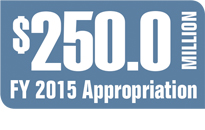
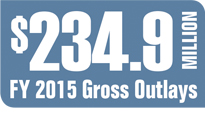
This statement provides information about the provision of budgetary resources and its status as of the end of the year. Information in this statement is consistent with budget execution information and the information reported in the Budget of the U.S. Government, FY 2015.
The Commission’s Total Budgetary Resources increased by $31.6 million to $250 million, or 6.4 percent, primarily due to an increase in appropriations of $35 million, which was 16.3 percent higher than the FY 2014 appropriated amount of $215 million.
Gross Outlays increased by $30.2 million, or 14.8 percent, due to more funds spent in FY 2015 then in FY 2014, primarily due to the $35 million, 0r 16.3 percent, increase in appropriations received.
Actual Offsetting Collections decreased by $176.3 million, or 99.9 percent, primarily due to a $176.1 million civil monetary sanctions collection recovered from the Treasury in FY 2014.
-
Statement of Custodial Activity
Total Cash Collections
($ in millions)Registration and Filing Fees $1.6 Fines, Penalties, and Forfeitures $2,841.2 General Proprietary Receipts $–* Total Cash Collections $2,842.8 * Total cash collections include $6.7 thousand, or <$1, in general proprietary receipts. (back to text)
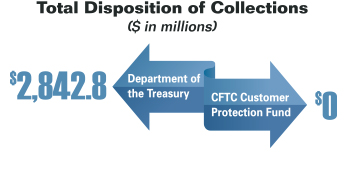
This statement provides information about the sources and disposition of collections. CFTC transfers eligible funds from dedicated collections to the CFTC Customer Protection Fund when the balance falls below $100 million and other non-exchange revenue to the Treasury general fund. Collections primarily consist of fines, penalties, and forfeitures assessed and levied against businesses and individuals for violations of the CEA or Commission regulations. They also include non-exchange revenues such as registration, filing, appeal fees, and general receipts. The Statement of Custodial Activity reflects total cash collections for FY 2015 in the amount of $2.8 billion, an increase of $1.9 billion, or 200.8 percent, over FY 2014. This increase in collections was expected due to nine large collections in FY 2015 ranging in amounts from $35 million to $800 million that resulted from the Commission’s enforcement cases related to attempted manipulation of global foreign exchange and LIBOR benchmark rates. Of the $2.8 billion in FY 2015 cash collections, all $2.8 billion was transferred to the Treasury because the CFTC Customer Protection Fund balance exceeded $100 million so no collections were eligible to be transferred to it.
Historical experience has indicated that a high percentage of custodial receivables prove uncollectible. An allowance for uncollectible accounts has been established and included in the accounts receivable on the Balance Sheet. The allowance is based on past experience in the collection of accounts receivables and an analysis of outstanding balances. Accounts are re-estimated quarterly based on account reviews and a determination that changes to the net realizable value are needed.
-
Limitations of Financial Statements
Management has prepared the accompanying financial statements to report the financial position and operational results for the CFTC for FY 2015 and FY 2014 pursuant to the requirements of Title 31 of the U.S. Code, section 3515 (b).
While these statements have been prepared from the books and records of the Commission in accordance with GAAP for Federal entities and the formats prescribed by OMB Circular A-136, Financial Reporting Requirements, these statements are in addition to the financial reports used to monitor and control budgetary resources, which are prepared from the same books and records.
The statements should be read with the understanding that they represent a component of the U.S. government, a sovereign entity. One implication of this is that the liabilities presented herein cannot be liquidated without the enactment of appropriations, and ongoing operations are subject to the enactment of future appropriations.
Other Information
Other Information contains the CFTC awards, consumer protection advisory on fraud, information about the CFTC Whistleblower Program, and contacts and acknowledgements.
-
CFTC Awards
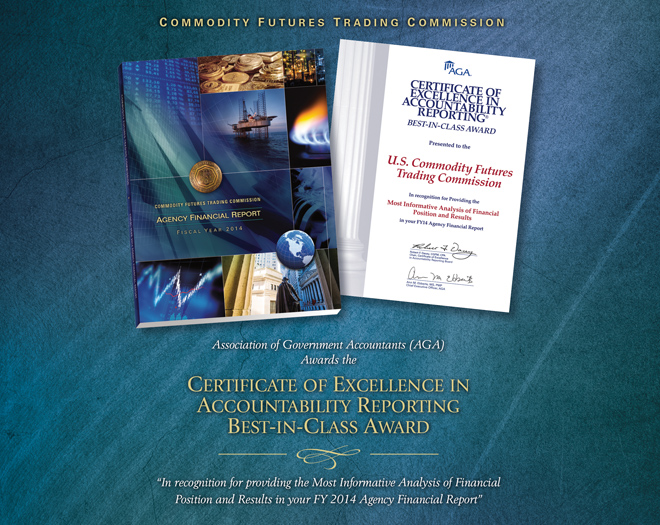
-
CFTC Consumer Protection: Fraud Awareness, Prevention and Reporting

Trading Futures and Options: Protection Against Fraud
The CFTC is the Federal agency that regulates the trading of futures, option and swaps contracts in the United States and takes action against firms or individuals suspected of illegally or fraudulently selling commodity futures, options, and swaps. The CFTC’s fraud awareness, prevention and reporting initiatives involve: developing an outreach effort designed to help individual investors/traders identify and avoid fraud, or encourage them to report known or suspected instances of it.
About the Futures Markets
- Individual investors/traders or “retail customers” rarely ever trade commodity futures and options.
- Trading commodity futures and options is a volatile, complex, and risky venture.
- Many individual traders lose all of their initial payment, and they could owe more than the initial payment.
- Some individual investors/traders unknowingly fall for completely fraudulent schemes which cause tremendous financial loss and emotional hardships.
Before you trade
Know the basics in futures trading
- Consider your financial experience, goals and resources, and determine how much you can afford to lose above and beyond your initial payment.
- Understand commodity futures and options contracts and your obligations in entering into them.
- Understand your exposure to risk and other aspects of trading by thoroughly reviewing disclosure documents your broker is required to give you.
- Know that trading on margin can make you responsible for losses much HIGHER than the amount you initially invested.
- Immediately contact CFTC if you have a problem or question.
Watch out for these warning signs
- Get-rich-quick schemes that sound too good to be true. Once your money is gone, it may be impossible to get it back.
- Predictions or guarantees of large profits. Always get as much information as you can about a firm or individual’s track record and verify that information.
- Firms or individual who say there is little risk. Written risk disclosure statements are important to read thoroughly and understand.
- Calls or emails from strangers about investment or trading opportunities.
- Requests for immediate cash or money transfers by overnight express, the Internet, mail, or any other method.
What should you do?
Visit the our Web site for more information:
www.cftc.gov/ConsumerProtectionReport possible violations of commodity futures trading laws:
Call the CFTC’s Division of Enforcement at:
866-FON-CFTC (866.366.2382)Submit our online form located at:
www.cftc.gov/ConsumerProtection/FileaTiporComplaintSend us a letter addressed to:
Commodity Futures Trading Commission
Office of Cooperative Enforcement
1155 21st Street, NW, Washington, DC 20581 -
CFTC Whistleblower Program
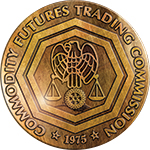
The CFTC Whistleblower
Program—created by the Dodd-
Frank Act—allows for payment
of monetary awards to eligible
whistleblowers, and provides
anti-retaliation protections for
whistleblowers, who share
information with
or assist the CFTC.How does the Whistleblower Program work?
- The CFTC will pay monetary awards to eligible whistleblowers who voluntarily provide the CFTC with original information about violations of the CEA that leads the CFTC to bring enforcement actions that result in more than $1 million in monetary sanctions.
- The CFTC can also pay whistleblower awards based on monetary sanctions collected by other authorities in actions that are related to a successful CFTC enforcement action, and are based on information provided by a CFTC whistleblower.
- The total amount of a whistleblower award will be between 10 and 30 percent of the monetary sanctions collected in either the CFTC action or the related action.
Who can be a whistleblower?
- A whistleblower can be any individual who voluntarily provides the CFTC original information, from a corporate officer or insider, to a trader or market observer, to an investor or fraud victim.
How can I become a whistleblower?
To become a whistleblower, you must complete and submit a Form TCR either electronically, by mail or by facsimile.
To submit a Form TCR electronically, visit http://www.cftc.gov, and click on the “File a Tip or Complaint” button on the right-hand side of the page. Use the first link under the description of the Whistleblower Program.
To submit a Form TCR by mail or facsimile, print a Form TCR from the “Whistleblower Program” webpage on http://www.cftc.gov, and use the following address or number:
Commodity Futures Trading Commission
Whistleblower Office
1155 21st Street, NW, Washington, DC 20581
Fax: 202.418.5975Am I protected against retaliation?
The Dodd-Frank Act prohibits retaliation by employers against individuals who are whistleblowers who provide the CFTC with information about possible violations of the CEA, or who assist the CFTC in any investigation or proceeding based on such information.
Learn more about the anti-retaliation provisions by reading Appendix A to the Whistleblower Rules.
How can I learn more?
Visit the “Whistleblower Program” webpage at https://www.whistleblower.gov, which has copies of the Whistleblower rules, filing forms, notices, orders on award applications, and frequently asked questions.
-
Contacts and Acknowledgements
Contacts
Additional copies of the
Commodity Futures Trading Commission
FY 2015 Summary of Performance and Financial Information
are available by contacting the following:Commodity Futures Trading Commission
Financial Management Branch
Three Lafayette Centre
1155 21st Street, N.W.
Washington, DC 20581Telephone: Mary Jean Buhler, 202.418.5089 or Lisa Malone, 202.418.5184
Fax: 202.418.5414
E-mail: [email protected] or [email protected]
Web: http://www.cftc.gov/About/CFTCReports/index.htmAcknowledgements
This Summary of Performance and Financial Information was produced with the energies and talents of Commission staff. To these individuals, the Financial Management Branch would like to offer our sincerest thanks and acknowledgement.
We would also like to acknowledge the Office of the Inspector General and KPMG LLP for the professional manner in which they conducted the audit of the Fiscal Year 2015 Financial Statements.
We offer our special thanks to The DesignPond, in particular Sheri Beauregard and Michael James, for their outstanding contribution to the design of this report.
FY 2015 Commissioners
FY 2015 Commissioners present the group photo of the 2015 commissioners and bios for each commissioner. Mark P. Wetjen served as a Commissioner until August 28, 2015. Two seats are presently vacant.
-
FY 2015 Commissioners
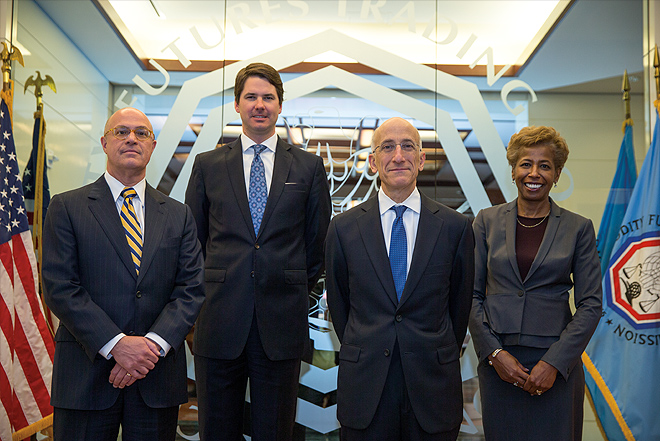
From left to right; J. Christopher Giancarlo, Commissioner; Mark P. Wetjen, Commissioner; Timothy G. Massad, Chairman;
Sharon Y. Bowen, Commissioner -
Chairman Timothy G. Massad

Timothy Massad was sworn-in as Chairman of the CFTC on June 5, 2014, after being confirmed by the U.S. Senate as Chairman and as a Commissioner of the CFTC.
Previously, Mr. Massad was nominated by President Obama and confirmed by the U.S. Senate as the Assistant Secretary for Financial Stability at the U.S. Department of the Treasury (Treasury). In that capacity, Mr. Massad oversaw the Troubled Asset Relief Program (TARP), the principal U.S. governmental response to the 2008 financial crisis designed to help stabilize the economy and provide help to homeowners. Under TARP, Treasury’s investments in financial institutions, the credit markets and the auto industry prevented the economy from falling into a depression. Mr. Massad was responsible for the day-to-day management and recovery of TARP funds, and during his tenure, Treasury recovered more on all the crisis investments than was disbursed. Mr. Massad also served as Chief Counsel for the program prior to becoming Assistant Secretary.
Prior to joining Treasury, Mr. Massad served as a legal advisor to the Congressional Oversight Panel for TARP, under the leadership of (now Senator) Elizabeth Warren. Mr. Massad assisted the panel in its first report evaluating the investments made by Treasury under TARP.
Prior to his government service, Mr. Massad was a partner in the law firm of Cravath, Swaine & Moore, LLP. Mr. Massad had a broad corporate practice with a focus on corporate finance and financial markets. He helped to draft the original standardized agreements for swaps and helped many businesses negotiate and execute transactions to hedge exposures in the derivatives markets.
Mr. Massad earned his bachelor’s and law degrees at Harvard. Mr. Massad was born in New Orleans, Louisiana, and also lived in Texas, Oklahoma and Connecticut as a child. He and his wife, Charlotte Hart, live in Washington with their two children.
-
Commissioner Sharon Y. Bowen

Sharon Y. Bowen was sworn in as a Commissioner of the CFTC on June 9, 2014 for a five-year term.
Ms. Bowen was previously confirmed by the U.S. Senate and appointed by President Obama on February 12, 2010 to serve as Vice Chair of the Securities Investor Protection Corporation (SIPC). She assumed the role of Acting Chair in March 2012. Prior to her appointment to the CFTC, Ms. Bowen was a partner in the New York office of Latham & Watkins LLP. Ms. Bowen’s broad and diverse corporate and transactional practice of almost 32 years began in 1982 when she started her career as an associate at Davis Polk & Wardwell. She joined Latham as a senior corporate associate in the summer of 1988 and became a partner January 1991.
Ms. Bowen’s practice has included corporate, finance, and securities transactions for large global corporations and financial institutions, including mergers and acquisitions, private equity, securities offerings, strategic alliances, corporate restructurings, leveraged finance, securitizations, distressed debt and asset acquisitions, and venture capital financings.
Ms. Bowen served in several leadership positions in her firm, including co-chair of the Diversity Committee, co-chair of the Diversity Hiring Subcommittee and co-founder and head of Latham’s Women Enriching Business (WEB) Task Force, whose mission is to create broader networks and productive business development relationships for women.
Ms. Bowen has been involved in numerous pro bono, educational, diversity and civic matters throughout her career and has received many awards in recognition of her contributions. She has served as a member of the Board (formerly Executive Committee and Chair) and Emeritus Board of New York Lawyers for the Public Interest, Inc., the Boards of New York City Economic Development Corporation (formerly Executive Committee), Northwestern University Law School (formerly Executive Member and Chair), and Public Education Needs Civil Involvement in Learning (PENCIL) (formerly Executive Committee).
Ms. Bowen is one of America’s “Top Black Lawyers” according to Black Enterprise Magazine. She is a recipient of the 2011 Diversity Trailblazer Award of the New York State Bar Association, and was selected as the New York City Bar Association 2007 Diversity Champion and the Metropolitan Black Bar Association 2006 Lawyer of the Year.
Ms. Bowen was born in Chesapeake, Virginia. She received her B.A. in Economics from the University of Virginia, MBA from the Kellogg School of Management and J.D. from Northwestern University School of Law. She lives with her husband in New York City.
-
Commissioner J. Christopher Giancarlo
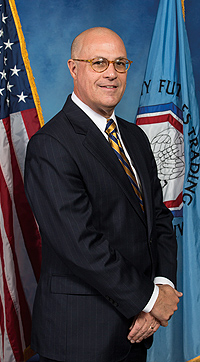
J. Christopher “Chris” Giancarlo was nominated by President Obama on August 1, 2013 and confirmed by unanimous consent of the U.S. Senate on June 3, 2014. On June 16, 2014, Mr. Giancarlo was sworn in as a CFTC Commissioner for a term expiring in April 2019.
Before entering public service, Mr. Giancarlo served as the Executive Vice President of GFI Group Inc., a financial services firm. Prior to joining GFI, Mr. Giancarlo was Executive Vice President and U.S. Legal Counsel of Fenics Software and was a corporate partner in the New York law firm of Brown Raysman Millstein Felder & Steiner. Mr. Giancarlo joined Brown Raysman from Giancarlo & Gleiberman, a law practice founded by Mr. Giancarlo in 1992 following his return from several years in London with the international law firm of Curtis, Mallet-Prevost, Colt & Mosle.
Mr. Giancarlo was also a founding Co-Editor-in-Chief of eSecurities, Trading and Regulation on the Internet (Leader Publications). In addition, Mr. Giancarlo has testified three times before Congress regarding the implementation of the Dodd-Frank Act, and has written and spoken extensively on public policy, legal and other matters involving technology and the financial markets.
Mr. Giancarlo was born in Jersey City, New Jersey. He attended Skidmore College in Saratoga Springs, New York where he graduated Phi Beta Kappa with Government Department Honors. Mr. Giancarlo received his law degree from the Vanderbilt University School of Law where he was an associate research editor at the Vanderbilt Journal of Transnational Law and President of the Law School’s International Law Society. Mr. Giancarlo has been a member of the Bar of the State of New York since 1985.
-
Commissioner Mark P. Wetjen
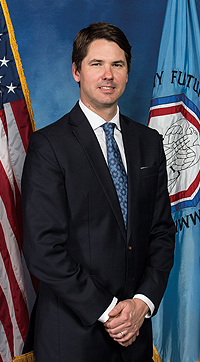 Mark P. Wetjen served as a Commissioner until August 28, 2015. His seat is presently vacant.
Mark P. Wetjen served as a Commissioner until August 28, 2015. His seat is presently vacant.Mr. Wetjen was nominated by President Obama to serve a five-year term in March 2011 and was confirmed by the U.S. Senate in October 2011. Subsequent to his confirmation as commissioner, Mr. Wetjen was elected to serve as the CFTC’s acting chairman upon the departure of the previous chairman, Gary Gensler, in 2013. Mr. Wetjen served in that role for approximately five months, managing daily operations and setting overall policy direction of the Commission. During his chairmanship, Mr. Wetjen oversaw implementation of the first trading mandate for certain interest rate and credit default swaps (CDS) and approved or directed the Commission and its staff to undertake approximately 95 enforcement and implementing actions related to the Dodd-Frank Act and the CFTC’s other responsibilities under the Commodity Exchange Act (CEA).
Prior to joining the CFTC, Mr. Wetjen worked for seven years in the U.S. Senate as a senior leadership staffer advising on all financial-services-related matters, including the Dodd-Frank Act. Mr. Wetjen also advised Senator Harry Reid and members of the Democratic caucus on a number of banking, housing, communications, technology, and gaming policy issues and legislative initiatives.
Before his service in the U.S. Senate, Mr. Wetjen was a lawyer in private practice and represented clients in a variety of litigation, transactional and regulatory matters. Born and raised in Dubuque, Iowa, Mr. Wetjen received a bachelor’s degree from Creighton University and a law degree from the University of Iowa College of Law.







